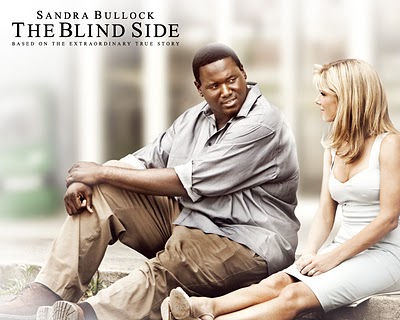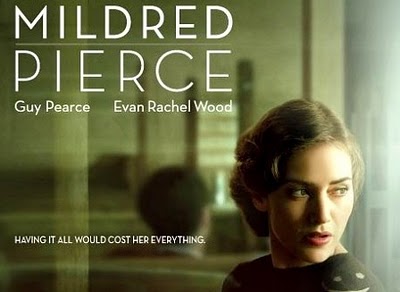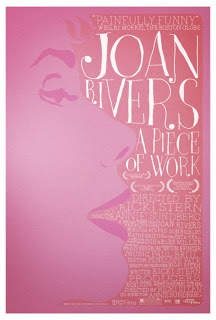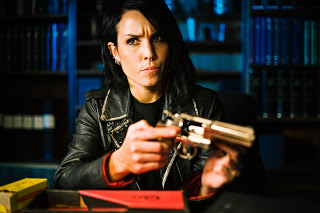Category: Uncategorized
In Memoriam: Elizabeth Taylor
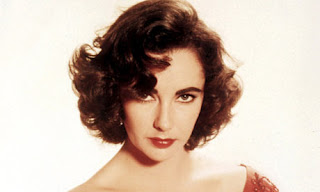 |
| Elizabeth Taylor 1932-2011 |
- Taylor won Best Actress Academy Awards for Who’s Afraid of Virginia Woolf
and Butterfield 8
. She was also nominated for the same award for Suddenly, Last Summer
, Cat on a Hot Tin Roof
, and Raintree County
. In 1993, the Academy awarded her the Jean Hersholt Humanitarian Award. Taylor is one of only five women to ever receive the honor.
- Other awards Taylor won include a BAFTA, a GLAAD Media Vanguard Award, three Golden Globes–including the Cecil B. DeMille Award (one of only twelve women to win since the award’s inception in 1952), a SAG Lifetime Achievement Award, and many others–even a Razzie, for her role in 1994’s The Flintstones
.
- Her first film role was in the film There’s One Born Every Minute, when she was only ten years old, which led to her status as a child star. Adulthood brought her hit after hit, including Cleopatra
in 1963, which was the most expensive movie to date with a budget of a million dollars. Her final feature film role was, unfortunately, in The Flintstones, though she appeared on television twice in 2001 and once on stage in 2007.
- Not only did Taylor collect jewelry, but she also designed a successful collection. Her perfume line, which includes Passion, White Diamonds, and Black Pearls, earns roughly 200 million dollars a year. Many celebrities followed in her footsteps, creating signature fragrances as part of their branding initiatives.
- Perhaps her most lasting legacy, other than her acting, is her HIV/AIDS activism. She raised over 100 million dollars to fight the disease, helped found the American Foundation for AIDS Research, and founded The Elizabeth Taylor HIV/AIDS Foundation.
This isn’t, by any means, an exhaustive list of her accomplishments and influence. Check out her obit at the New York Times and the interactive media imbedded within, including a clip from Who’s Afraid of Virginia Woolf, and leave your links to Elizabeth Taylor related pieces in the comments.
Guest Writer Wednesday: The Blind Side: The Most Insulting Movie Ever Made
Let me say up front that I’m aware that I’m supposed to feel sorry for Sandra Bullock this week. She’s purported to be “America’s sweetheart” and all, she has always seemed like a fairly decent person (for an actor), and I think her husband deserves to get his wang run over by one of his customized asshole conveyance vehicles, but I’m finding it difficult to feel too bad. I mean, who marries a guy who named himself after a figure from the Old West, has more tattoos than IQ points, and is known for his penchant for rockabilly strippers? Normally I’d absolve Bullock of all responsibility for what has occurred and spend nine paragraphs illustrating the many reasons Jesse James doesn’t deserve to live, but I’ve just received proof in the form of a movie called The Blind Side that Sandra Bullock is in cahoots with Satan, Ronald Reagan’s cryogenically preserved head, the country music industry, and E! in their plot to take over the world by turning us all into (or helping some of us to remain) smug, racist imbeciles.
The movie chronicles the major events in the life of a black NFL player named Michael Oher from the time he meets the rich white family who adopts him to the time that white family sees him drafted into the NFL, a series of events that apparently proves that racism is either over or OK (I’m not sure which), with a ton of southern football bullshit along the way. Bullock plays Leigh Anne Tuohy, the wife of a dude named Sean Tuohy, played by — no shit — Tim McGraw, who is a fairly minor character in the movie despite the fact that he is said to own, like, 90 Taco Bell franchises. The story is that Oher, played by Quinton Aaron, is admitted into a fancy-pants private Christian school despite his lack of legitimate academic records due to the insistence of the school’s football coach and the altruism of the school’s teachers (as if, dude), where he comes into contact with the Tuohy family, who begin to notice that he is sleeping in the school gym and subsisting on popcorn. Ms. Tuohy then invites him to live in the zillion-dollar Memphis Tuophy family compound, encourages him to become the best defensive linebacker he can be by means of cornball familial love metaphors, and teaches him about the nuclear family and the SEC before beaming proudly as he’s drafted by the Baltimore Ravens.
I’m sure that the Tuohy family are lovely people and that they deserve some kind of medal for their good deeds, but if I were a judge, I wouldn’t toss them out of my courtroom should they arrive there bringing a libel suit against whoever wrote, produced, and directed The Blind Side, because it’s handily the dumbest, most racist, most intellectually and politically insulting movie I’ve ever seen, and it makes the Tuohy family — especially their young son S.J. — look like unfathomable assholes. Well, really, it makes all of the white people in the South look like unfathomable assholes. Like these people need any more bad publicity.
Quentin Aaron puts in a pretty awesome performance, if what the director asked him to do was look as pitiful as possible at every moment in order not to scare anyone by being black. Whether that was the goal or not, he certainly did elicit pity from me when Sandra Bullock showed him his new bed and he knitted his brows and, looking at the bed in awe, said, “I’ve never had one of these before.” I mean, the poor bastard had been duped into participating in the creation of a movie that attempts to make bigoted southerners feel good about themselves by telling them that they needn’t worry about poverty or racism because any black person who deserves help will be adopted by a rich family that will provide them with the means to a lucrative NFL contract. Every interaction Aaron and Bullock (or Aaron and anyone else, for that matter) have in the movie is characterized by Aaron’s wretched obsequiousness and the feeling that you’re being bludgeoned over the head with the message that you needn’t fear this black guy. It’s the least dignified role for a black actor since Cuba Gooding, Jr.’s portrayal of James Robert Kennedy in Radio (a movie Davetavius claims ought to have the subtitle “It’s OK to be black in the South as long as you’re retarded.”). The producers, writers, and director of this movie have managed to tell a story about class, race, and the failures of capitalism and “democratic” politics to ameliorate the conditions poor people of color have to deal with by any means other than sports while scrupulously avoiding analyzing any of those issues and while making it possible for the audience to walk out of the theater with their selfish, privileged, entitled worldviews intact, unscathed, and soundly reconfirmed.
Then there’s all of the southern bullshit, foremost of which is the football element. The producers of the movie purposely made time for cameos by about fifteen SEC football coaches in order to ensure that everyone south of the Mason-Dixon line would drop their $9 in the pot, and the positive representation of football culture in the film is second in phoniness only to the TV version of Friday Night Lights. Actually, fuck that. It’s worse. Let’s be serious. If this kid had showed no aptitude for football, is there any way in hell he’d have been admitted to a private school without the preparation he’d need to succeed there or any money? In the film, the teachers at the school generously give of their private time to tutor Oher and help prepare him to attend classes with the other students. I’ll bet you $12 that shit did not occur in real life. In fact, I know it didn’t. The Tuohy family may or may not have cared whether the kid could play football, but the school certainly did. It is, after all, a southern school, and high school football is a bigger deal in the South than weed is at Bonnaroo.
But what would have happened to Oher outside of school had he sucked at football and hence been useless to white southerners? What’s the remedy for poverty if you’re a black woman? A dude with no pigskin skills? Where are the nacho magnates to adopt those black people? I mean, that’s the solution for everything, right? For all black people to be adopted by rich, paternalistic white people? I know this may come as a shock to some white people out there, but the NFL cannot accommodate every black dude in America, and hence is an imperfect solution to social inequality. I know we have the NBA too, but I still see a problem. But the Blind Side fan already has an answer for me. You see, there is a scene in the movie which illustrates that only some black people deserve to be adopted by wealthy white women. Bullock, when out looking for Oher, finds herself confronted with a black guy who not only isn’t very good at appearing pitiful in order to make her comfortable, but who has an attitude and threatens to shoot Oher if he sees him. What ensues is quite possibly the most loathsome scene in movie history in which Sandra Bullock gets in the guy’s face, rattles off the specs of the gun she carries in her purse, and announces that she’s a member of the NRA and will shoot his ass if he comes anywhere near her family, “bitch.” Best Actress Oscar.
Well, there it is. Now you see why this movie made 19 kajillion dollars and won an Oscar: it tells a heartwarming tale of white benevolence, assures the red state dweller that his theory that “there’s black people, and then there’s niggers” is right on, and affords him the chance to vicariously remind a black guy who’s boss thr0ugh the person of America’s sweetheart. Just fucking revolting.
There are several other cringe-inducing elements in the film. The precocious, cutesy antics of the family’s little son, S.J., for example. He’s constantly making dumb-ass smart-ass comments, cloyingly hip-hopping out with Oher to the tune of Young M.C.’s “Bust a Move” (a song that has been overplayed and passe for ten years but has now joined “Ice Ice Baby” at the top of the list of songs from junior high that I never want to hear again), and generally trying to be a much more asshole-ish version of Macaulay Culkin in Home Alone. At what point will screenwriters realize that everyone wants to punch pint-sized snarky movie characters in the throat? And when will I feel safe watching a movie in the knowledge that I won’t have to endure a scene in which a white dork or cartoon character “raises the roof” and affects a buffalo stance while mouthing a sanitized rap song that even John Ashcroft knows the words to?
And then there’s the scene in which Tim McGraw, upon meeting his adopted son’s tutor (played by Kathy Bates) and finding out she’s a Democrat, says, “Who would’ve thought I’d have a black son before I met a Democrat?” Who would have thought I’d ever hear a “joke” that was less funny and more retch-inducing than Bill Engvall’s material?
What was the intended message of this film? It won an Oscar, so I know it had to have a message, but what could it have been? I’ve got it (a suggestion from Davetavius)! The message is this: don’t buy more than one Taco Bell franchise or you’ll have to adopt a black guy. I’ll accept that that’s the intended message of the film, because if the actual message that came across in the movie was intentional, I may have to hide in the house for the rest of my life.
I just don’t even know what to say about this movie. Watching it may well have been one of the most demoralizing, discouraging experiences of my life, and it removed at least 35% of the hope I’d previously had that this country had any hope of ever being anything but a cultural and social embarrassment. Do yourself a favor. Skip it and watch Welcome to the Dollhouse again.
Miniseries Preview: Mildred Pierce
Set in Glendale, California, in the 1930s, Mildred Pierce is the story of a middle-class housewife’s attempt to maintain her and her family’s social position during the Great Depression. Frustrated by her unemployed cheating husband, and worried by their dwindling finances, Mildred separates from him and sets out to support herself and her children on her own.
After a difficult search, she finally finds a job as a waitress, but she worries that it is beneath her middle-class station. Actually, Mildred worries more that her ambitious elder daughter, Veda, will think her new job is demeaning. Mildred encounters both success and tragedy, opening three successful restaurants and operating a pie-selling business, and coping with the death of her younger daughter, Ray. Veda enjoys Mildred’s newfound financial success, but increasingly turns ungrateful, demanding more and more from her hard-working mother and letting her contempt for people who must work for a living be known. Mildred’s attachment to Veda forms the central tragedy in the novel.
…Mildred Pierce is a triumph from beginning to end, and the casting in supporting roles couldn’t be bettered: Melissa Leo does her best Aline MacMahon as Mildred’s next-door neighbor Mrs. Gessler, while Mare Winningham seems to have sprung straight out of a 1930s diner as Ida (in the Crawford version, the sardonic Eve Arden played Ida like a valued secretary doing a bit of slumming in the restaurant trade). Haynes lets his female characters operate as they would have at the time in this milieu. He doesn’t do any modern editorializing on their plight and he doesn’t outright celebrate their resourcefulness; instead, he sets up a panorama of female struggle and solidarity and views it distantly, like somebody writing a history book and trying to keep personal opinions out of it.
Asked recently about his longstanding attraction to the melodramatic form known as the woman’s picture–“the untouchable of film genres,” as the critic Molly Haskell once put it–the director Todd Haynes had a ready answer.
“Stories about women in houses are the real stories of our lives,” he said. “They really tell what all of us experience in one way or another because they’re stories of family and love and basic relationships and disappointments.”
Framed as a whodunit–it opens with the killing of Mildred’s second husband, the rakish Monty Beragon–the original “Mildred Pierce” has long been a staple of feminist film theory, which generally views it as a conflicted genre hybrid that combines the masculine conventions of film noir and the feminine ones of melodrama.
Documentary Review: Joan Rivers: A Piece of Work
 |
| Joan Rivers: A Piece of Work |
Watching the film, however, gave me a new appreciation for Rivers–even while not sharing a number of her perspectives. A Piece of Work documents a year in Rivers’ life: she turns 75, faces down a heckler at a stand-up show in Wisconsin, honors George Carlin in a tribute, gets roasted by Comedy Central, and injects new life into her career by winning Celebrity Apprentice. All while still selling that damn jewelry. Her energy level is astounding, and I wonder how she manages to do all she does at the age of 75.
Rivers is an odd character. Being a superstar female comic alone is odd in the U.S.–only a few came before her–but we get a very real look at her life, at the troubles she has faced (her husband’s suicide) and continues to face, and at the loneliness that certainly helps her drive to fill her daily calendar. She is vulnerable and still nervous when going on stage, especially when pursuing what she calls the one sacred part of her life–her acting–in which she hasn’t seen a lot of personal success. I came to find her more compelling and interesting than my initial perception of her, and encourage anyone to see this film and learn more about a woman who refuses to stop.
Guest Writer Wednesday: The Girl Who Played with Fire
 |
|
| Good Girl Gone Bad: Noomi Rapace as Lisbeth Salander Burns Up the Screen in The Girl Who Played with Fire |
On Rape, the Media, and the ‘New York Times’ Clusterfuck
Residents in the neighborhood where the abandoned trailer stands—known as the Quarters—said the victim had been visiting various friends there for months. They said she dressed older than her age, wearing makeup and fashions more appropriate to a woman in her 20s. She would hang out with teenage boys at a playground, some said.
Actually…no. I just read the “offending” comments of Mr. McKinley. The complaint is that he “gave ink” to the opinions of some idiots from Texas? He’s a reporter for Christ’s sake. He’s SUPPOSED to present all angles of the story. Looks like responsible journalism to me. Attack the idiots in Texas for this. Attack the wretched perpetrators. Why in the world is anyone mad at The New York Times for telling the whole story? If anything its GOOD that they reported on those folks as well. Its important for people to know that there are idiots like that everywhere. This is wildly misplaced rage here. Wasting time on things like this is why no real problems ever get solved in this damn country. Let the public burning commence. I’ll be tied to the stake willingly. =)
And we’ve noticed a few things here and there: rape being played for laughs in Observe and Report; the sexual trafficking of women used as a plot device in Taken; the constant dismemberment of women in movie posters; the damaging caricatures of women as sex objects in Black Snake Moan and The Social Network; and we’ve often pointed to discussions of sexism and misogyny around the net, like the sexual violence in Antichrist and, most recently, the sexualized corpses of women in Kanye West’s Monster video. It barely grazes the surface. I mean, it barely grazes the fucking surface of what a viewer sees during the commercial breaks of a 30-minute sitcom.
The sudden idealization of Charlie Sheen as some bad boy to be envied, even though he has a violent history of beating up women, contributes to the rape of women and girls. Bills like H. R. 3 that seek to redefine rape and further the attack on women’s reproductive rights contributes to the rape of women and girls. Supposed liberal media personalities like Michael Moore and Keith Olbermann showing their support for Julian Assange by denigrating Assange’s alleged rape victims contributes to the rape of women and girls. The sexist commercials that advertisers pay millions of dollars to air on Super Bowl Sunday contribute to the rape of women and girls. And blaming Lara Logan for her gang rape by suggesting her attractiveness caused it, or the job was too dangerous for her, or she shouldn’t have been there in the first place, contributes to the rape of women and girls.
… in a very real way, ignoring “the little things” in favor of “the big stuff” makes the big stuff that much harder to eradicate, because it is the pervasive, ubiquitous, inescapable little things that create the foundation of a sexist culture on which the big stuff is dependent for its survival. It’s the little things, the constant drumbeat of inequality and objectification, that inure us to increasingly horrible acts and attitudes toward women.
2011 NAACP Image Awards
 |
| The 42nd annual NAACP Image Awards |
Ideas and images create the belief systems that control our individual and societal actions. When it comes to forming ideas, reinforcing stereotypes, establishing norms and shaping our thinking nothing affects us more than the images and concepts delivered into our lives on a daily basis by television, motion picture, recordings and literature. Accordingly, there is ample cause for concern about what does or does not happen in these mediums when there is little or no diversity in either opportunities or the decision making process.
Outstanding Motion Picture:
For Colored Girls – winner
Just Wright
The Book of Eli
The Kids Are All Right
Tyler Perry’s Why Did I Get Married Too?
Outstanding Actress in a Motion Picture:
Halle Berry for Frankie & Alice – winner
Janet Jackson for Tyler Perry’s Why Did I Get Married Too?
Kerry Washington for Night Catches Us (check out Arielle Loren’s guest post)
Queen Latifah for Just Wright
Zoe Saldana for The Losers
Outstanding Supporting Actress in a Motion Picture:
Anika Noni Rose for For Colored Girls
Kimberly Elise for For Colored Girls – winner
Phylicia Rashad for For Colored Girls
Whoopi Goldberg for For Colored Girls
Jill Scott for Tyler Perry’s Why Did I Get Married Too?
Outstanding Independent Motion Picture:
Conviction
Frankie & Alice – winner
La Mission
Mother and Child
Night Catches Us
Outstanding Directing in a Motion Picture (Theatrical or Television):
Geoffrey Sax for Frankie & Alice
George Tillman, Jr. for Faster
Tanya Hamilton for Night Catches Us
The Hughes Brothers for The Book of Eli
Tyler Perry for For Colored Girls – winner
Guest Writer Wednesday: Bridesmaids Preview
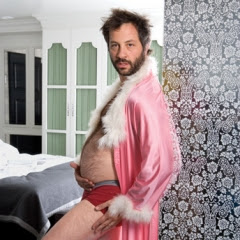 |
| Judd Apatow puts on some panties in Bridesmaids |
Having turned 18 at the birth of the Sex and the City era, college and adulthood came at a time when sexual expression and alcohol could be worn like Girl Scout badges, proudly and with accomplishment. It was the best of times (that I could remember) and the worst of times (that were gladly hazy). The graduates of the millennium celebrated leaving the sophomoric comedy of American Pie and blissfully embraced the gratuitous ass shots of Will Ferrell. And just as quickly as we got on “double-secret-probation” in college,” we just as quickly matriculated from it. Now working stiffs and pissed off about having $160,000 in college debt, Judd Apatow appeared to ease our pain with raunchy and outrageous humor.
 But then my heart sank as I read about the other comedy he’s producing, unimaginatively called Bridesmaids (release date May 2011). Written by and starring Kristen Wiig, the movie is about “a maid of honor trying to please the snobby, eccentric or really awkward bridesmaids at every pre-wedding event before her best friend’s nuptials.” Given Wiig’s successful comedic record, it’s clear she can hang with the funniest of dudes, and I’m willing to bet she lays down some solid jokes in Bridesmaids, but that type of movie has graced the big screen before with lamer jokes and interchangeable blondes and brunettes – cue the bridezilla, bridesmaid dress fat jokes, Vera Wang and a heart warming, seen-the-error-of-our-ways ending.
But then my heart sank as I read about the other comedy he’s producing, unimaginatively called Bridesmaids (release date May 2011). Written by and starring Kristen Wiig, the movie is about “a maid of honor trying to please the snobby, eccentric or really awkward bridesmaids at every pre-wedding event before her best friend’s nuptials.” Given Wiig’s successful comedic record, it’s clear she can hang with the funniest of dudes, and I’m willing to bet she lays down some solid jokes in Bridesmaids, but that type of movie has graced the big screen before with lamer jokes and interchangeable blondes and brunettes – cue the bridezilla, bridesmaid dress fat jokes, Vera Wang and a heart warming, seen-the-error-of-our-ways ending.Documentary Review: The September Issue
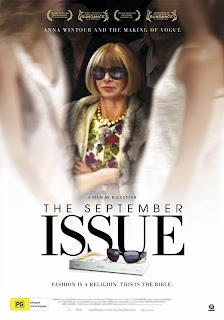 |
| The September Issue |
I like fashion. It’s an art form, and its creators are capable of beautiful design and cultural statements. It’s also an industry, and like all major industries, has a very ugly side. I liken it to professional sports: I watch from the sidelines, aware of the way I’m being manipulated, but enjoy it nonetheless—all without expressly participating.
Eventually, Coddington gets so palsy-walsy that she puts one of the September Issue cameramen into a last-minute photo shoot as a prop. The resulting pictures are fresh and fun and even manage to make Anna smile, although it’s not clear if she likes the pics or is just enjoying telling a middle-aged cameraman that he’s too fat. When Coddington hears that Wintour wants to Photoshop out his belly, she gets on the phone and threatens the art director and tells him that he has to leave it alone. “Not everything can be perfect in the world,” she rails. It is the climax of the movie, where Coddington eventually triumphs over the tyrant, who has been chipping away at her artistic integrity for the entire 90 minutes.
While Coddington expresses enormous respect for Wintour, she isn’t afraid to speak her mind. Pontificating on the magazine in the back of a car, she mentions how little she likes the rise of celebrity culture and the practice of using actresses as cover models (the fall fashion issue features Sienna Miller on the cover), but concedes that Wintour knew this was the future of fashion mags and put the idea into action first.
Yes, there is drama in the film, and some of it even seems like stereotypical fashion magazine fare, but what remains remarkable is seeing two talented women in their sixties running a fashion empire, working together, clashing over their visions for the issue, all while expressing enormous respect for one another, and doing it all with intelligence and glamour.
Guest Writer Wednesday: The Girl with the Dragon Tattoo
 |
| Rebel with a Cause: A Feminist Heroine Emerges in film The Girl with the Dragon Tattoo |
This is a cross post from Opinioness of the World.
The story revolves around the disappearance of Harriet Vanger, the niece of a wealthy business tycoon, who vanished without a trace 40 years earlier. Harriet’s uncle has been tortured by her absence all these years. Journalist Mikael Blomkvist, who’s been convicted of libel, and Lisbeth Salander, an introverted punk who’s a brilliant researcher and hacker, seek to solve the baffling mystery. The book is a riveting twisting thriller with numerous suspects.
Blomkvist is an interesting character. A charming and passionate journalist championing for the truth, he vacillates between cynicism and naïveté. Dejected after his conviction, he yearns to clear his name. He also frequently bed hops yet has enormous respect for women, often befriending them. While acclaimed Swedish actor Michael Nyqvist gives a valiant effort, he does not imbue the character with enough charisma.
But the sole reason to go see the movie (and read the book too) is for Lisbeth Salander. Noomi Rapace, who won a Guldbagge Award (the Swedish Oscars) for her portrayal, plays her perfectly. She stepped into the role by training for 7 months through Thai boxing and kickboxing (in the books Lisbeth boxes too) as well as piercing her eyebrow and nose, emulating Lisbeth’s punk look. A nuanced performance, Rapace plays the tattooed warrior with the right blend of sullen introvert, keen intellect and fierce survivor instincts. Salander is a ferocious feminist, crusading for women’s empowerment. Facing a tortured and troubled past, Salander is resourceful and resilient, avenging injustices following her own moral compass. An adept actor, Rapace conveys emotions through her eyes, never needing to utter a word. Yet she can also invoke Salander’s visceral rage when warranted.

Also, if you’re like me and reading each book before you see the film and you haven’t read the second book yet, be prepared for spoilers as there are scenes NOT in the first book that are taken from the second book and integrated into the film, such as Lisbeth’s flashbacks and the topic of her conversation with her mother.
 In the book, Larsson makes social commentaries on fiscal corporate corruption, ethics in journalism, and the role of upbringing on criminal behavior. Larsson also provides an interesting commentary on gender roles with his two protagonists. Despite Blomkvist’s social nature and Salander’s private behavior, they both stubbornly follow their own moral code. Both also possess overt sexualities. Yet society views Blomkvist as socially acceptable and perceives Salander as an outcast. These themes are absent from the movie adaptation.
In the book, Larsson makes social commentaries on fiscal corporate corruption, ethics in journalism, and the role of upbringing on criminal behavior. Larsson also provides an interesting commentary on gender roles with his two protagonists. Despite Blomkvist’s social nature and Salander’s private behavior, they both stubbornly follow their own moral code. Both also possess overt sexualities. Yet society views Blomkvist as socially acceptable and perceives Salander as an outcast. These themes are absent from the movie adaptation.
The Girl with the Dragon Tattoo has received an exorbitant amount of attention for Larsson’s controversial central theme of violence against women. It’s true that both the book and film portray graphic violence. The movie does not shy away from the uncomfortable subject matter. In the book, women fall prey to being assaulted, murdered, and violently raped. A pivotal rape scene disturbs and haunts the viewer. But sexual assault is a reality women face, albeit an ugly truth that we as a society may not want to see. Yet Larsson in the book and Oplev in the film never made me feel as if women were victimized. On the contrary, women, particularly in the form of Salander, are powerful survivors. She fights back, not merely accepting her circumstances.
As Melissa Silverstein of Women & Hollywood wrote in Forbes,
As my friend playwright Theresa Rebeck says, “The world looks at women who fight back as crazy.” We constantly see movies, TV shows and plays where men commit violence against women. That’s our norm. Here we have a woman who is saying no more and exacts revenge. Larsson is very clearly saying what we all know and believe. Lisbeth is not crazy. She is a feminist hero of our time.
Violence against women is a pervasive issue. According to the anti-sexual assault organization RAINN, “every 2 minutes in the U.S., someone is sexually assaulted; nearly half of these victims are under the age of 18, and 80 percent are under 30.” And in Sweden, the problem is just as pervasive. Larsson states that “46 percent of the women in Sweden have been subjected to violence by a man.” We must not continue to brush these crimes aside. The original Swedish title of The Girl with the Dragon Tattoo (both the book and the film) is Män Som Hatar Kvinnor, which translates to “Men Who Hate Women.” I’m glad that Larsson devoted his books to shedding light on misogyny in society.
A provocative and haunting film, The Girl with the Dragon Tattoo is worthy of watching for Rapace’s subtle yet powerful performance. It’s rare for an audience to see a strong, self-sufficient woman on-screen. It’s even more unusual for a movie to address the stigma of sexual assault as well as the complexity of gender roles. Watch the movie and read the book. Get acquainted with Lisbeth Salander; she may be the most exhilarating, unconventional and surprising character you will ever encounter.
Best Picture Nominee Review Series: 127 Hours
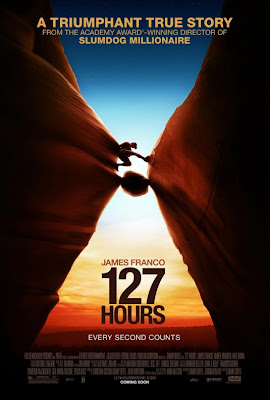
The rest of the movie takes place in the canyon–a claustrophobic nightmare that only works because Franco is apparently an amazing actor–and inside Franco’s mind, through flashbacks of his super hot (gasp) blond ex-girlfriend and the phone calls from his mom and sister that he clearly stupidly ignored prior to his departure. He also hallucinates some crazy shit, like a giant Scooby-Doo blowup doll that’s soundtracked to that ghoulish laughter reminiscent of the last few seconds of Thriller. Yeah! And though it sounds absolutely insane, it’s why the film works. Boyle takes a narrative about a guy struggling to get out of a hole and turns it into an action film, a radio show, a documentary, a commercial, a disaster movie, a cartoon, and a comedy. About a guy struggling to get out of a hole.
Not that there aren’t a few impossible-to-deal-with moments. The final scene, which is poignant enough on its own, insists on beating the audience over the head with its call to EXPERIENCE EMOTION, courtesy of this ridiculous Dido & A.R. Rahman song. And I still can’t quite figure out how the closeup shots of ice-encased Gatorade and Mountain Dew add anything more than advertising revenue, as much as I’d like to argue that, “If I were trapped in a cave, about to die, drinking my own urine, toying with the idea of amputating a limb, I’d totally hallucinate all these brand-name beverages from Pepsico.”
And yes, god, seriously, The Women. I know this is a movie about Ralston’s journey. I respect that and enjoyed watching the innovative ways Boyle used split screens, reverse zooms, fantastical elements, warped focus, and speed variations to tell Ralston’s story in a way I can’t imagine another director successfully telling it. That doesn’t mean I could ignore my own cringing every time a woman entered the frame. The ex-girlfriend clearly serves as a vehicle to show Ralston’s loner-ness; see, he pushed her away all cliche-like. We know this because she says Very Important Things to him. “You’re going to be so lonely,” she yells, after he silently (but with his eyes!) asks her to leave a sporting event they’re attending. (I want to say hockey?)
His hallucinations suck, too. His sister shows up in a wedding dress. His sister showing up in a wedding dress clearly serves as a vehicle to make us feel bad that he’ll be missing Very Important Life Events if he dies, like his sister’s wedding. More pointlessly, the hallucinated sister, who might have one speaking line if I’m being generous, is played by Lizzy Caplan, an actress who’s had large roles in True Blood, Party Down, Hot Tub Time Machine, Cloverfield, and Mean Girls. Instead of engaging with the film, I found myself taken completely out of it, as I wondered why they would cast an actress who’s clearly got more skills than standing in a wedding dress, looking sullen and disappointed, to stand in a wedding dress looking sullen and disappointed.
So, the first two women (the lost ones) show Ralston’s carefree coolness. The ex-girlfriend illustrates Ralston’s darkness and his need for independence–as do the voicemails he ignores from his mother and sister, which are played in flashback. His sister reminds the audience that Ralston has Things to Live For. Hell, Ralston even tries to console his mother in advance (when he records his deathbed goodbye with his video cam) by saying things like, “Don’t feel bad about buying me such cheap, crappy mountain climbing equipment Mom … I mean, how were you supposed to know this would happen!” Hehe. What? Apparently it’s easier to use every possible cliche ever of how men and women interact (as a way to reveal information about the hero’s personality and psyche) than it is to, I don’t know, show him interacting with some guys? Have him flashback-interact with Dad? Nope, we get Lost Women in Need, Wedding Dresses, and Mommy Blaming. And I haven’t even gotten to the masturbation scene yet.
[This is your Spoiler Alert.]
I struggled with the masturbation scene. Because it’s a failed masturbation scene. I mean, it’s a scene where masturbation is attempted unsuccessfully. I didn’t like that he took out his video camera and freeze-framed and zoomed in on a woman’s breasts from earlier–as far as I’m concerned, there’s no other way to look at that than as classic Objectification (and dismemberment) of Women. (Also, the audience laughed, and I was taken out of the film yet again.) But at the same time … whoa. Ralston knows he’s about to die. He’s out of water. He’s got no hope of being rescued. Ultimately, masturbation for him is an act of desperation, the desire to feel something that his body has already let go of. Yes–it’s powerful stuff. Watching Ralston’s body betray him shows his imminent physical death.
But it felt too much like The Ultimate Betrayal. As much as I sympathized with Ralston–and Franco is brilliant in this scene–I don’t want to let the film off the hook entirely. I mean, what’s with men and their dicks? If I’m trapped down there, I’m thinking, “A little less masturbation, a little more amputation.” Honestly. The scene played too much like a metaphor for his final loss of power (read: masculinity), as impotence usually does on-screen. In that moment, I no longer identified with the film’s initial overarching theme of hope and possible redemption; I just thought, “Oh man, he can’t get it up it. SNAP.” I guess I’m just wondering if the film really needed to go there …
So, aside from the women “characters” being cliched, pointless, slightly offensive insertions used only to further our understanding of Ralston, 127 Hours is a fabulous film. I’m not even being sarcastic. I’ve never been much of a Franco fan–I mean, apparently he’s teaching a class about himself now?–but this performance is a game-changer for James and me. Boyle certainly showed his directing chops, too; this movie goes places a viewer would never expect–in fact, I don’t think I’ve ever seen anything like it. I cried. I eye-rolled. I looked away (often). And I laughed. Especially at the end of the film, when the woman behind me said, “Wait. You mean that shit was a true story?!”

